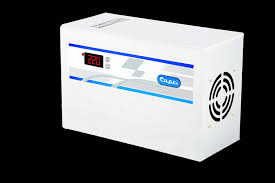Introduction of AC stabilizer
An AC stabilizer, also known as a voltage stabilizer or voltage regulator, is an electrical device designed to protect electrical appliances, including air conditioning (AC) units, from voltage fluctuations in the power supply. Voltage fluctuations can occur due to various factors, such as changes in the power grid, electrical surges, or inadequate wiring in the electrical system.
The primary function of an AC stabilizer is to ensure a steady and consistent supply of voltage to the connected AC unit. It accomplishes this by regulating the incoming voltage and providing a stable output voltage within a predetermined range that is safe for the operation of the AC unit.
How Can AC Stabilizer Protect My AC Unit From Voltage Fluctuations?
An AC stabilizer, also known as a voltage stabilizer or voltage regulator, is a device designed to protect electrical appliances, including AC units, from voltage fluctuations.
Voltage Regulation:
AC stabilizers are designed to regulate the incoming voltage to a consistent and safe level. They employ various techniques, such as transformers and electronic circuits, to detect and compensate for fluctuations in the input voltage. When the stabilizer detects a voltage increase or decrease, it adjusts the voltage output to ensure a stable and suitable level for your AC unit. This steady voltage supply protects the AC unit’s internal components, such as the compressor, motors, and electronic circuitry, from potential damage caused by high or low voltage conditions.
Surge Protection:
Voltage surges or spikes, which are sudden increases in voltage, can pose a significant risk to electronic appliances like AC units. These surges can result from lightning strikes, power grid switching, or faulty electrical equipment. AC stabilizers often incorporate surge protection mechanisms, such as surge suppressors or metal oxide varistors (MOVs), which divert excess voltage away from the connected AC unit. These protective components absorb or shunt the excess voltage to prevent it from reaching the AC unit and causing damage to its sensitive components. By diverting the surge away from the AC unit, the stabilizer shields it from the harmful effects of voltage spikes.
Voltage Cutoff:
In extreme cases of voltage fluctuations, such as extremely high or low voltages, AC stabilizers may have a voltage cutoff feature. This feature is designed to automatically disconnect the power supply to the AC unit when the voltage exceeds or falls below a certain threshold. For instance, if the voltage exceeds a safe upper limit, the stabilizer cuts off the power supply to prevent the AC unit from operating under potentially hazardous conditions. Similarly, if the voltage drops too low, the cutoff feature safeguards the AC unit by disconnecting it from the power source. This voltage cutoff mechanism acts as a fail-safe protection measure to prevent severe damage to the AC unit when voltage levels become dangerously abnormal.
Voltage Display:
Many AC stabilizers are equipped with a voltage display that provides real-time information about the input voltage level. The display typically shows the voltage readings, allowing you to monitor the voltage fluctuations and assess the stability of the power supply. By observing the voltage display, you can identify any irregularities in the power source and take necessary precautions or contact an electrician if the voltage deviates significantly from the desired range. The voltage display feature enables you to actively monitor the stabilizer’s performance and ensure that your AC unit receives a consistent and safe power supply.
Overall, an AC stabilizer plays a vital role in protecting your AC unit from voltage fluctuations. By regulating the voltage, offering surge protection, incorporating voltage cutoff mechanisms, and providing real-time voltage information, the stabilizer ensures that your AC unit operates within safe parameters. This protection helps to prolong the lifespan of your AC unit, minimize the risk of malfunctions, and prevent potential damage caused by voltage variations, ultimately saving you from costly repairs or replacements.
What are the potential risks of not using an AC stabilizer?
Not using an AC stabilizer can expose your AC unit to several potential risks and problems. These include:
Voltage Fluctuations:
Without an AC stabilizer, your AC unit becomes vulnerable to voltage fluctuations in the power supply. Fluctuations can lead to sudden increases or decreases in voltage, which can cause damage to the AC unit’s components. High voltage spikes can overload the electrical circuits, burn out motors or compressors, and potentially result in irreparable damage. On the other hand, low voltage levels can lead to improper functioning, reduced cooling capacity, and increased strain on the AC unit.
Power Surges:
Power surges, which are sudden and brief increases in voltage, can occur due to lightning strikes, power grid issues, or when power is restored after an outage. These surges can damage sensitive electronic components within the AC unit, such as the control board or compressor. Without an AC stabilizer’s surge protection feature, the AC unit is susceptible to these voltage spikes, leading to costly repairs or even total system failure.
Inconsistent Performance:
Voltage fluctuations can cause inconsistent performance of your AC unit. Fluctuating voltage levels can affect the efficiency and cooling capacity of the AC unit. The unit may struggle to maintain the desired temperature, resulting in discomfort and decreased energy efficiency. Inconsistent performance can also lead to frequent on/off cycling of the AC unit, increasing wear and tear on the components and reducing the lifespan of the unit.
Reduced Lifespan:
Continuous exposure to voltage fluctuations without proper protection can significantly shorten the lifespan of your AC unit. The stress caused by voltage spikes, drops, or inconsistent voltage supply can accelerate the deterioration of electrical components, such as motors, compressors, and control boards. This can result in more frequent breakdowns, costly repairs, and the need for premature replacement of the AC unit.
Safety Hazards:
Voltage fluctuations can pose safety hazards. High voltage spikes can potentially damage other connected appliances or electrical devices in your home. Furthermore, severe voltage fluctuations can cause electrical fires or other electrical hazards if not properly managed or protected.
Overall, not using an AC stabilizer puts your AC unit at risk of damage, reduced performance, and increased maintenance costs. Investing in a reliable AC stabilizer helps protect your AC unit from voltage fluctuations, ensures consistent performance, extends its lifespan, and provides peace of mind regarding the safety of your electrical system.
Also read:- Ranking the Top 10 Refurbished Laptops India
Conclusion
In conclusion, an AC stabilizer is a crucial device for protecting your AC unit from voltage fluctuations. By regulating the voltage, offering surge protection, and providing voltage cutoff mechanisms, an AC stabilizer ensures that your AC unit receives a consistent and safe power supply. Without an AC stabilizer, your AC unit is vulnerable to voltage spikes, drops, and inconsistent voltage levels, which can lead to damage, reduced performance, and shortened lifespan. Additionally, voltage fluctuations can pose safety hazards and increase the risk of electrical fires or other electrical issues. Investing in a reliable AC stabilizer is a wise choice to safeguard your AC unit, enhance its efficiency, and avoid costly repairs or replacements in the long run.




